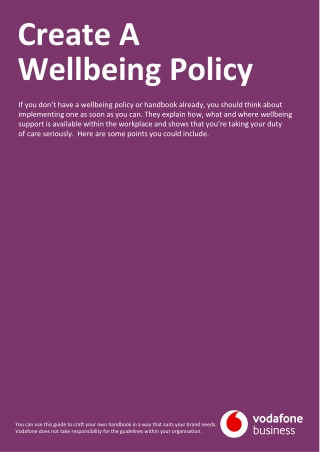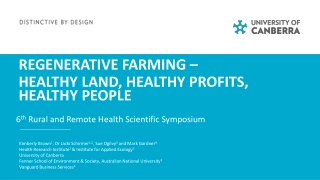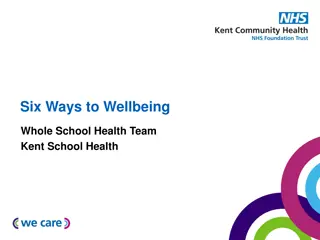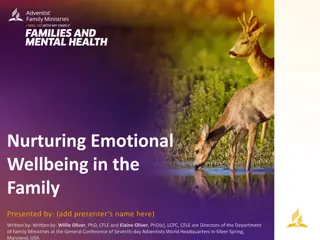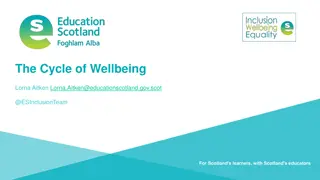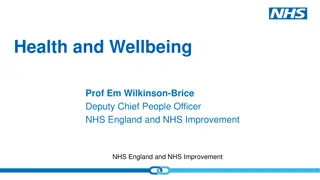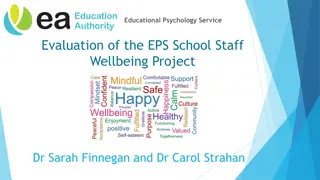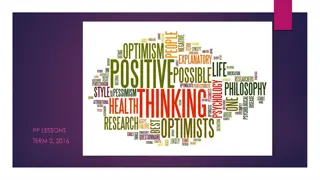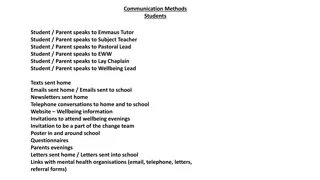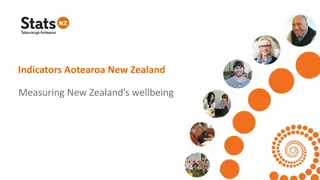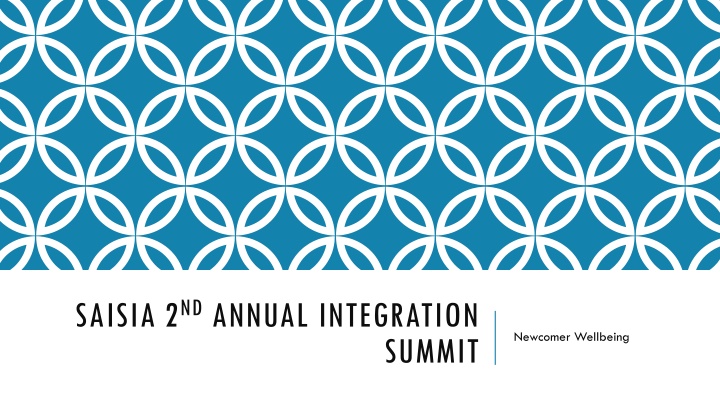
Immigrant Wellbeing and Mental Health in Social Contexts
Explore the impact of social determinants on immigrant health, focusing on mental health challenges, refugee situations, and risk factors such as forced migration and discrimination. Learn how cultural and structural factors intersect to influence immigrant wellbeing and healthcare access.
Download Presentation

Please find below an Image/Link to download the presentation.
The content on the website is provided AS IS for your information and personal use only. It may not be sold, licensed, or shared on other websites without obtaining consent from the author. If you encounter any issues during the download, it is possible that the publisher has removed the file from their server.
You are allowed to download the files provided on this website for personal or commercial use, subject to the condition that they are used lawfully. All files are the property of their respective owners.
The content on the website is provided AS IS for your information and personal use only. It may not be sold, licensed, or shared on other websites without obtaining consent from the author.
E N D
Presentation Transcript
SAISIA 2NDANNUAL INTEGRATION Newcomer Wellbeing SUMMIT
MENTAL HEALTH Mental health is a state of well-being in which an individual realizes his or her own abilities, can cope with the normal stresses of life, can work productively and is able to make a contribution to his or her community Source: Promoting mental health: concepts, emerging evidence, practice. WHO, 2004 http://www.who.int/mental_health/evidence/en/promoting_mhh.pdf
RELEVANCE OF SOCIAL DETERMINANTS OF HEALTH FRAMEWORK An emphasis on cultural explanations and the omission of structural factors in immigrant research provides incomplete generalizations about migrant health (Abraido-Lanza et al., 2006; Hunt et al., 2004). A broad social determinants of health framework, which underlines social and structural explanations that create and reproduce social and health inequities, and an examination of the interactions between culture and structural inequality, may enhance our understanding of immigrant health (Abraido-Lanza et al., 2006; Acevedo-Garcia et al., 2012; Zambrana and Carter- Pokras, 2010).
SOCIAL DETERMINANTS OF HEALTH 1. Income and social status 2. Employment and working conditions 3. Education and literacy 4. Childhood experiences 5. Physical environments 6. Social supports and coping skills 7. Healthy behaviours 8. Access to health services 9. Biology and genetic endowment 10. Gender 11. Culture https://www.canada.ca/en/public-health/services/health-promotion/population-health/what-determines-health.html
QUICK FOCUS ON REFUGEE SITUATIONS Refugees, asylum seekers, and undocumented migrants are at particularly high risk of mental health disorders and problems. Issues include post traumatic stress, depression, suicides, anxiety, and psychosis, all exacerbated by the uncertainty and challenges of settlement. Barriers to getting help include: language issues, ignorance about health care systems and benefits, different attitudes and beliefs (including cultural) about health care and healing; and lack of trust or faith in health care professionals and professionals, and those in positions of authority.
RISK FACTORS Involuntary or forced migration High expectations, unmet expectations Discrimination and racism Risk factors for women when there are assumptions that women will provide greater emotional support to others; and when there are demands and expectations about the role that women play in supporting extended family and others. Ethnic enclaves or communities where there is high immigrant population may pose risks for immigrants since they may begin to feel stuck or segregated. (Arevalo, Tucker, & Falcon, 2015).
WHO MENTAL HEALTH ACTION PLAN 2013-2020 Objectives of the 2013-2020 WHO Mental Health Action plan: Strengthening leadership and governance for mental health; Ensuring that community based programming to respond to mental health wellness is comprehensive, integrated, and responsive; Implementing strategies for mental health promotion and prevention; Continuing to enhance mental health information systems and research http://www.who.int/mental_health/action_plan_2013/en/ June 6, 2018 report: Progress values for 2016 indicate that the global targets can be reached, only if there is a collective global commitment that leads to substantial investment and expanded efforts at country level for mental health policies, laws, programmes and services across all Member States.
SUSTAINABLE DEVELOPMENT GOALS (SDGS) The strategic plan of the United Nations Development Programme (UNDP) focuses on key areas including poverty alleviation, democratic governance and peacebuilding, climate change and disaster risk, and economic inequality. Since 2016, the SDGs or Global goals have been guiding the work of the UNDP. UNDP provides support to governments to integrate the SDGs into their national development plans and policies http://www.undp.org/content/undp/en/home/sustainable-development- goals.html. Goal 3 of 17 is on Good health and well-being: Ensure healthy lives and promote well-being for all at all ages: Promotion of mental health and well-being, and substance abuse prevention have been included as priorities within the global development agenda (the Sustainable Development Agenda). http://www.undp.org/content/undp/en/home/sustainable-development-goals.html
CONTINUING TO BUILD MOMENTUM: CONSISTENT MESSAGING The Global Burden of Disease provides a tool to identify the prevalence of disease, the risk factors, and the harm that is caused (http://www.healthdata.org/gbd/about); The Global Burden of Disease research ranks depression third and projects it will rank first by 2030; The Department of Economic and Social Affairs, Division for Inclusive Social Development talks about mental health and development: Poor mental health is both a cause and a consequence of poverty, compromised education, gender inequality, ill-health, violence and other global challenges. It impedes the individual s capacity to work productively, realize their potential and make a contribution to their community. https://www.un.org/development/desa/disabilities/issues/mental-health-and-development.html
WHO EUROPE RECOMMENDATIONS: RELEVANCE TO THE PRAIRIES? Supporting social integration through education, housing and employment; Providing outreach services to facilitate access to care; Coordinating different services within the health care system to ensure the integration of physical and mental health care and appropriate care pathways; Providing information on care entitlements and available services to migrants and health care professionals; Training health care professionals to ensure that they are open towards migrant groups, aware of their barriers to accessing care and interacting with health services, and skilled in overcoming language problems.
PROTECTIVE FACTORS Pre and post migration factors Neighbourhood ethnic density or high immigrant concentrations may be particularly beneficial to those who have just arrived Strong social supports and networks Social participation and community engagement, including volunteerism Language proficiency (Arevalo, Tucker, & Falcon, 2015).
CHARITY BEGINS AT HOME? HOW ARE WE DOING? HOW AM I DOING? Trauma and violence informed approaches https://www.canada.ca/en/public-health/services/publications/health-risks-safety/trauma-violence- informed-approaches-policy-practice.html Remembering the impact of past of current situations of violence, (including cumulative effects) Avoiding blaming and judging people who are responding, in their own way, to these histories of violence. Instead, listen , validate, build trust, be strengths based. Reducing harm and improving systems Recognizing vicarious trauma and providing supports Workers and service providers may experience emotional exhaustion, depression, and sleep disturbances Employers can continue to encourage self care. Recognizing lateral violence and bullying
LATERAL VIOLENCE AND BULLYING Bullying is defined as offensive abusive, intimidating, malicious or insulting behavior, or abuse of power conducted by an individual or group against others, which makes the recipient feel upset, threatened, humiliated or vulnerable, which undermines their self confidence and which may cause them to suffer stress Task Force on Prevention of Workplace Bullying, 2001, p. 10) Personal bullying: gossiping about an individual; Workplace bullying includes criticizing an individual s work;
LATERAL AND HORIZONTAL VIOLENCE Lateral and Horizontal bullying has been described as involving members of oppressed groups (those lacking power or having personal problems) turning their anger and hostility towards each other. May also involve people bullying for career advancement, to promote themselves in a better light, or to put down others Etienne, 2014) Involves psychological harassment; May include verbal abuse, humiliation, excessive criticism, exclusion, lack of collegial support. Now includes bullying via the internet and social media.
CONCLUSIONS Rather, the right to health refers to the right to the enjoyment of a variety of goods, facilities, services and conditions necessary for its realization (p. 5). Conversely, individuals right to health cannot be realized without realizing their other rights, the violations of which are at the root of poverty, such as the rights to work, food, housing and education, and the principle of non-discrimination (p. 6). Office of the United Nations High Commissioner on Human Rights and the World Health Organization. The right to health. Fact Sheet No. 31.
REFERENCES Arevalo, S. P., Tucker, K. L., & Falcon, L. M. (2015. Beyond cultural factors to understand immigrant mental health: Neighborhood ethnic density and the moderating role of pre-migration and post-migration factors. Social Science and Medicine Vol 138, 91-100. Ditmer, D. (2011). Violence in the house of healing: Recognition and response to violence in health care. The Forensic Examiner 20.(1).14-29. Etienne, E. (2014). Exploring workplace bullying in Nursing. Workplace health and safety Vol 62, Issue 1. 6-11, DOI:10.3928/21650799-2012-220-02. Centre for American Nurses (2008). Lateral violence and bullying in the workplace. USA: Author. Government of Canada (2018). Social determinants of health and health inequalities. Accessed at https://www.canada.ca/en/public-health/services/health-promotion/population-health/what-determines-health.html https://www.canada.ca/en/public-health/services/publications/health-risks-safety/trauma-violence-informed-approaches-policy-practice.html Office of the United Nations High Commissioner on Human Rights and the World Health Organization. The right to health. Fact Sheet No. 31. Accessed at https://www.ohchr.org/Documents/Publications/Factsheet31.pdf https://www.canada.ca/en/public-health/services/publications/health-risks-safety/trauma-violence-informed-approaches-policy-practice.html http://www.healthdata.org/gbd/about http://www.who.int/mental_health/action_plan_2013/en/ http://www.undp.org/content/undp/en/home/sustainable-development-goals.html. http://www.undp.org/content/undp/en/home/sustainable-development-goals.html https://www.un.org/development/desa/disabilities/issues/mental-health-and-development.html


